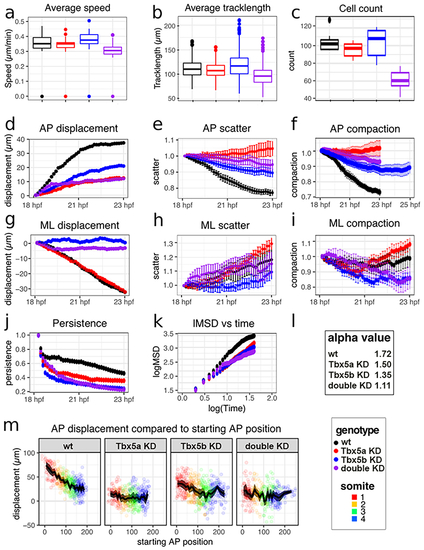Fig. 5
- ID
- ZDB-FIG-230112-5
- Publication
- Anderson et al., 2021 - Tbx5a and Tbx5b paralogues act in combination to control separate vectors of migration in the fin field of zebrafish
- Other Figures
- All Figure Page
- Back to All Figure Page
|
Cell tracking statistics show that knock-down cells are still able to migrate but lose aspects of directed movement.
For graphs a-k, the ‘genotype’ key at bottom right shows that black represents wt data, red represents Tbx5a knock-down data, blue represents Tbx5b knock-down data and purple represents double knock-down data. The ‘somite’ key at bottom right refers to panel m. Error bars represent standard error. (a) Boxplots depicting average speed of each time cell at each time point per embryos (b) Boxplots depicting average track length per genotype. (c) Boxplots depicting the average number of cells in the fin field. (d) AP displacement over time, displacement is in μm. (e) Scatter along the AP axis over time. (f) AP compaction factor over time. (g) ML displacement over time. (h) ML scatter over time. (i) ML compaction factor over time. (j) Persistence plotted over time. (k) Log mean square displacement versus log time. (l) Average alpha value calculated from previous plot of lMSD vs time. (m) Each colored point represents the total displacement for a single track with respect to starting position. The black line represents the mean displacement with respect to starting position, with the surrounding shaded region representing the 95% confidence interval. |
Reprinted from Developmental Biology, 481, Anderson, E.B., Mao, Q., Ho, R.K., Tbx5a and Tbx5b paralogues act in combination to control separate vectors of migration in the fin field of zebrafish, 201-214, Copyright (2021) with permission from Elsevier. Full text @ Dev. Biol.

